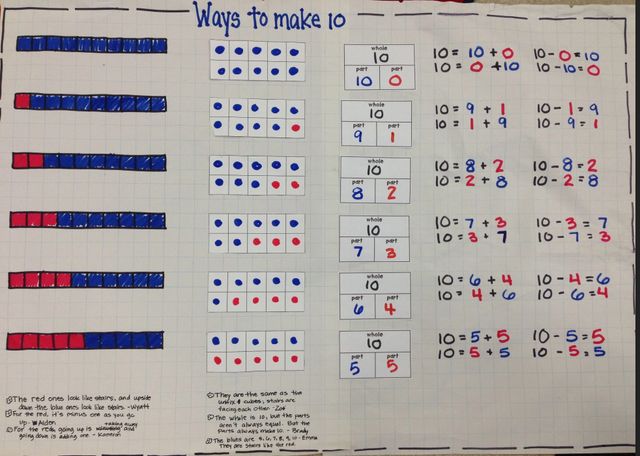The Power of Fives and Tens
by Valerie Henry, Ed.D.

I've been thinking a lot about this comment recently -- especially because the data I've collected over the years continues to demonstrate that a blend of all five FactsWise principles produces the most powerful results. In classrooms where only a few of the principles are implemented, students are less likely to make the amazing advances we see in classrooms where all five principles are fully implemented.
The key reason I decided to prioritize 5s and 10s in both add/subtract and multiply/divide has everything to do with my experiences interacting with people who are mathematically confident. Almost without exception, these boys and girls, men and women use flexible mental math strategies with ease. And many of these strategies utilize 5 and 10 as benchmarks.
When students can easily find sums and differences, products and quotients involving 5s and 10s, they have the tools they need to solve more complex problems. In the FactsWise mini-lesson video below, you'll see 4th grade dual-immersion students who are using 5s and 10s and other facts they know to reason about x8 facts they're still learning.
"I just recently realized that I've been focusing on individual Goal 1 facts, and not really helping students see the connections -- that all of them add up to either 4 or 5. Now that I've started prioritizing the 5s connection, students are seeing the commonalities between the facts and are becoming much more fluent and confident!" (FactsWise kindergarten teacher).
To help students make connections in the first four FactsWise addition/subtraction goals, consider calling the goals by their names rather than simply as Goal 1, Goal 2, etc. By naming them "Within 5", "With 5s", "Within 10" and "With 10s" (Goals 1 through 4 respectively), you and your students can continuously focus on the connections between the facts within each goal.
Focusing on the connections between FactsWise Multiply/Divide goals

FactsWise multiply/divide is designed to make it easy for teachers and students to make connections from one goal to the next. Goal 2 becomes much easier for students when they can make connections back to the x10s they learned in Goal 1. Goals 4 and 5 build off the fluency students develop in Goal 3. And the same holds true of Goals 6, 7 and 8.
My next post will take a look at mini-lesson activities that help you and your students make connections and build fluency with the foundational 5s and 10s.
If you'd like to learn more about FactsWise and how you can engage your students in powerful facts fluency learning experiences, you can preview and purchase FactsWise Resource Books and FactsWise Online Courses for Educators at www.factswise.com.
When students can easily find sums and differences, products and quotients involving 5s and 10s, they have the tools they need to solve more complex problems. In the FactsWise mini-lesson video below, you'll see 4th grade dual-immersion students who are using 5s and 10s and other facts they know to reason about x8 facts they're still learning.
The power of 5s and 10s starts showing up as early as Goal 5 in FactsWise Add/Subtract and continues all the way through Goal 9 and into the "secret" Goal 10 (two-digit mental math). The chart below illustrates several of the most common 5s and 10s strategies with problems from Goal 8 (With 9s).
Focusing on each FactsWise Add/Subtract goal as a related group of facts"I just recently realized that I've been focusing on individual Goal 1 facts, and not really helping students see the connections -- that all of them add up to either 4 or 5. Now that I've started prioritizing the 5s connection, students are seeing the commonalities between the facts and are becoming much more fluent and confident!" (FactsWise kindergarten teacher).
To help students make connections in the first four FactsWise addition/subtraction goals, consider calling the goals by their names rather than simply as Goal 1, Goal 2, etc. By naming them "Within 5", "With 5s", "Within 10" and "With 10s" (Goals 1 through 4 respectively), you and your students can continuously focus on the connections between the facts within each goal.
Focusing on the connections between FactsWise Multiply/Divide goals

FactsWise multiply/divide is designed to make it easy for teachers and students to make connections from one goal to the next. Goal 2 becomes much easier for students when they can make connections back to the x10s they learned in Goal 1. Goals 4 and 5 build off the fluency students develop in Goal 3. And the same holds true of Goals 6, 7 and 8.
My next post will take a look at mini-lesson activities that help you and your students make connections and build fluency with the foundational 5s and 10s.
If you'd like to learn more about FactsWise and how you can engage your students in powerful facts fluency learning experiences, you can preview and purchase FactsWise Resource Books and FactsWise Online Courses for Educators at www.factswise.com.






No comments:
Post a Comment